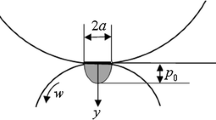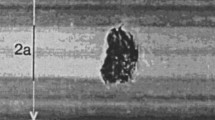Abstract
As one of the main failure modes of component operated under rolling contact loading, the rolling contact fatigue is classified into two types: subsurface initiated and surface initiated. Different stresses such as orthogonal shear stress, maximum principle shear stress, and octahedral shear stress have been applied as the critical stresses for the assessment of the subsurface cracks’ initiation due to rolling contact fatigue. The influences of friction on distributions of the ranges of orthogonal shear stress, maximum principle shear stress, and octahedral shear stress in subsurface were analyzed with reference to the results of the reference articles. The results show that friction does influence the subsurface distributions of these stresses to a certain extent. However, the upper limits of both the maximum principle shear stress and octahedral shear stress are smaller than that of range of orthogonal shear stresses under the rolling contact conditions of usual steel components. Hence, it is more appropriate that the orthogonal shear stress be selected as the critical stress for the assessment of subsurface rolling contact fatigue.






Similar content being viewed by others
References
Y. Ding, J.A. Gear, Spalling depth prediction model. Wear 267, 1181–1190 (2009)
C. Santus, M. Beghini, I. Bartilotta, Surface and subsurface rolling contact fatigue characteristic depths and proposal of stress indexes. Int. J. Fatigue 45, 71–81 (2012)
S. Farshid, J. Behrooz, S.S. Trevor et al., A review of rolling contact fatigue. J. Tribol. 131, 1–15 (2009)
G. Lundberg, A. Palmgren, Dynamic capacity of rolling bearings. Acta Polytech. Scand. Mech. Eng. Ser 3, 1–52 (1947)
Y. Miyashita, Y. Yoshimura, J.-Q. Xu, M. Horikoshi, Y. Mutoh, Subsurface crack propagation in rolling contact fatigue of sintered alloy. JSME Int. J. Ser. A 46, 341–347 (2003)
H. Schlicht, E. Schreiber, O. Zwirlein, Fatigue and failure mechanism of bearings. Inst. Mech. Eng. Conf. Publ. 1, 85–90 (1986)
T.A. Harris, W.K. Yu, Lundberg–Palmgren fatigue theory: considerations of failure stress and stressed volume. ASME Trans. J. Tribol. 121, 85–89 (1999)
A. Bernasconi, P. Davoli, M. Filippini et al., An integrated approach to rolling contact sub-surface fatigue assessment of railway wheels. Wear 258, 973–980 (2005)
A. Ekberg, E. Kabo, H. Andersson. Predicting rolling contact fatigue of railway wheels. 13th International Wheelset Congress in Rome, 2001, pp. 17–21
E. Kabo, R. Enblom, A. Ekberg, A simplified index for evaluating subsurface initiated rolling contact fatigue from field measurements. Wear 271, 120–124 (2011)
Ali Beheshti, M.M. Khonsari, On the prediction of fatigue crack initiation in rolling/sliding contacts with provision for loading sequence effect. Tribol. Int. 44, 1620–1628 (2011)
K. Kenji, S. Yukio, X-ray texture analysis on cyclic shearing deformation due to rolling contact fatigue. J. Soc. Mat. Sci. Jpn. 53, 300–305 (2004)
K. Kenji, I. Yasuo, S. Yukio, Texture development in surface layer of rail steel during rolling. J. Soc. Mater. Sci. Jpn. 37, 592–598 (1987)
A. Kapoor, F.J. Franklin, S.K. Wong et al., Surface roughness and plastic flow in rail wheel contact. Wear 253, 257–264 (2002)
Y. Akiniwa, S. Machiya, K. Tanaka, Fatigue damage evaluation in SiCp/2024 by x-ray diffraction method. Int. J. Fatigue 28, 1406–1412 (2006)
M. Mineur, P. Villechaise, J. Mendez, Influence of the crystalline texture on the fatigue behavior of a 316L austenitic stainless steel. Mater. Sci. Eng. A 286, 257–268 (2000)
D. Orlov, A. Vinogradov, The control of texture to improve high-cyclic fatigue performance in copper after equal channel angular pressing. Mater. Sci. Eng. A 530, 174–182 (2011)
K.L. Johnson, The strength of surface in rolling contact. Proc. Inst. Mech. Eng. 203, 151–163 (1989)
K.L. Johnson, Contact Mechanics (Cambridge University Press, Cambridge, 1985)
B. Gai, Elastic Mechanic (Harbin Institute of Technology Press, Harbin, 2009)
P. Dou, Y. Li et al., Finite element analysis of contact stresses on the backup roll of CVC hot rolling mills. J. Tsinghua Univ. (Sci &Technol) 45, 1668–1671 (2005)
H. Takechi, K. Namba, K. Fujiwara et al., Evaluation of subsurface fatigue damage in strip mill rolls by an x-ray diffraction method. Trans. Iron Steel Inst. Jpn. 21, 92–99 (1981)
Author information
Authors and Affiliations
Corresponding author
Rights and permissions
About this article
Cite this article
Qin, Xf., Sun, Dl. & Xie, Ly. Analysis of Critical Stress for Subsurface Rolling Contact Fatigue Damage Assessment Under Roll/Slide Contact. J Fail. Anal. and Preven. 14, 61–67 (2014). https://doi.org/10.1007/s11668-013-9762-6
Received:
Revised:
Published:
Issue Date:
DOI: https://doi.org/10.1007/s11668-013-9762-6




